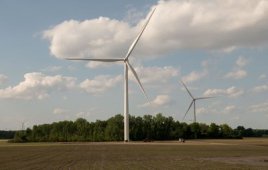Condition monitoring is one way to keep tabs on all the equipment in a nacelle without a daily visit. SCADA systems provide some of this information, but a properly applied condition monitoring system provides more detail.
The idea is to mount sensors on bearings, gearboxes, and generators. Pressure sensors can tell that the hydraulic system is up and running, while temperature sensors report on general oil, bearing, and generator conditions.
Accelerometers, however, may be most useful because they can track vibration in a bearing or gear train and, with special software called Fast Fourier Transform (FFT), provide useful information such as vibration frequency, which helps identify a particular bearing or gear. Then as a bearing wears, its frequency amplitude increases. This signal can be monitored from a center well away from the wind farm. The specifics of condition monitoring, however, are changing fast with many ideas for how it can be done.
Other condition monitoring issues involve adapting traditional sensors to today’s larger distributed base of wind turbines. These have thousands of measurement points which diminish the cost effectiveness and adds additional system and organization complexity.
By applying recent devices such as MEMS accelerometers and low-cost digital signal converters with Ethernet communication, wind-farm operators can deploy condition monitoring systems without a high level of vibration analysis knowledge, say some experts.
Based on extended monitoring and testing of 1.5-MW wind turbines, operators can learn to effectively monitor a turbine’s rotating equipment. The process, according to one expert, breaks into four action points: identify accelerometer locations inside the turbine, determine a monitoring method appropriate for each location, analyze the data, and communicate the data collection.
Today’s accelerometers are extremely compact, which allows easily mounting them near rotating components such as bearings and gears. Typical installation is by glue on mounting bases that require no modifications to turbine components.
Filed Under: Uncategorized




